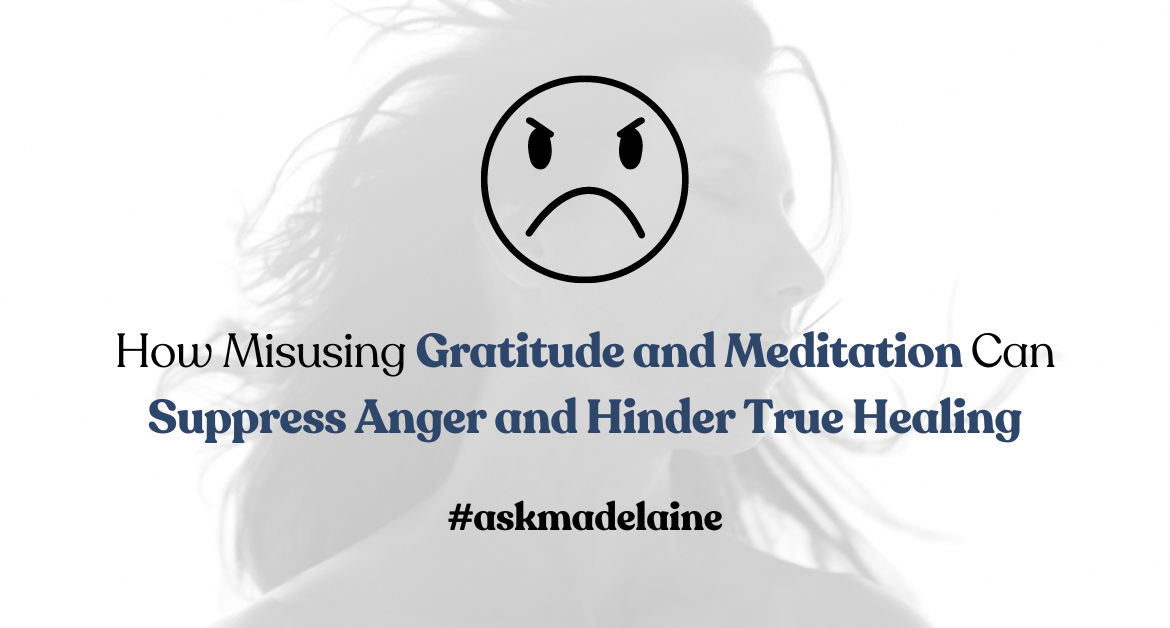

Toxic Positivity: How Misusing Gratitude and Meditation Can Suppress Anger and Hinder True Healing
In today’s wellness culture, tools like gratitude, meditation, and positive affirmations are often hailed as the keys to happiness and peace. While these practices undeniably offer immense benefits, there’s a growing concern that they can be misused in ways that may actually harm rather than heal. One such misuse is the tendency to employ these tools to “get rid of” or suppress negative emotions, particularly anger. This approach, known as toxic positivity, can lead to deeper issues if not addressed properly.
Understanding Toxic Positivity
Toxic positivity is the overgeneralisation of a happy, optimistic state across all situations. It’s the belief that we should always have a positive mindset, no matter what challenges we’re facing. While positivity itself is not the problem, it becomes toxic when it denies, minimises, or invalidates authentic emotional experiences.
For example, when someone expresses anger or frustration, they might be told to “just be grateful for what you have” or to “meditate and let it go.” While gratitude and meditation are powerful practices, using them as a blanket solution to avoid or suppress uncomfortable emotions like anger can lead to further emotional suppression and internal conflict.
The Problem with Suppressing Anger
Anger is a natural and important emotion. It signals that something is wrong, that a boundary has been crossed, or that an injustice has occurred. Suppressing anger, rather than addressing its root cause, can have serious consequences for both mental and physical health.
Research shows that unexpressed anger can contribute to a range of issues, including anxiety, depression, and physical health problems such as high blood pressure and heart disease (Davidson et al., 2000). When we force ourselves to “think positive” or use meditation solely to “get rid of” anger, we’re not truly processing the emotion. Instead, we’re pushing it deeper inside, where it can fester and grow.
How Misusing Gratitude and Meditation Can Backfire
Gratitude and meditation are incredibly beneficial when used correctly. They can help shift our focus, provide clarity, and promote inner peace. However, when used as tools to avoid dealing with negative emotions, they can become part of a harmful cycle of emotional suppression.
- Gratitude Misused: Instead of acknowledging legitimate anger, some may use gratitude as a way to dismiss their feelings. For example, telling oneself, “I should just be grateful and not feel angry about this,” denies the validity of the emotion and the underlying issue that needs attention.
- Meditation Misused: While meditation can help calm the mind and bring awareness, using it to “clear away” anger without addressing the source can lead to emotional bypassing. This occurs when meditation becomes a tool to avoid confronting difficult emotions, leading to unresolved inner conflict.
Signs You Might Be Suppressing Anger
Recognising the signs of suppressed anger is crucial for addressing the emotion in a healthy way. Some common signs include:
- Frequent Irritability: Suppressed anger can manifest as constant irritation or frustration over minor things.
– Physical Symptoms: Headaches, stomach issues, or muscle tension can all be signs that your body is holding onto anger.
- Passive-Aggressive Behaviour: If you find yourself being sarcastic, giving backhanded compliments, or avoiding direct confrontation, it could be a sign of suppressed anger.
- Emotional Numbness: Suppressing anger can also lead to a general numbness or inability to feel emotions deeply, as the effort to suppress one emotion often affects others as well
How to Use Anger as a Force for Good
Instead of suppressing anger, it’s essential to channel it in a way that leads to growth and healing. Here’s how to harness the power of anger constructively:
- Acknowledge the Emotion: The first step is to simply acknowledge that you’re feeling angry. Validate your feelings without judgment, recognising that anger is a natural response to certain situations.
- Explore the Cause: Take time to reflect on what’s causing your anger. Is it a boundary that’s been crossed? A sense of injustice? Understanding the root cause can help you address the underlying issue.
- Express It Healthily: Find ways to express your anger that are constructive rather than destructive. This could be through physical activity, creative outlets like writing or art, or having an honest conversation with the person involved.
- Integrate Mindfulness: Use meditation not to suppress anger but to observe it. Mindfulness practices can help you become aware of your anger without being consumed by it, allowing you to respond rather than react.
- Practice Gratitude with Intention: Rather than using gratitude to override your anger, practice it alongside acknowledging your feelings. You can be grateful for what you have while also recognising areas of your life where change is needed.
The Right Balance: Using Positivity as a Tool, Not a Mask
True emotional well-being comes from embracing the full spectrum of our emotions, including the uncomfortable ones. Gratitude, meditation, and positivity should enhance our emotional resilience, not mask or suppress our true feelings. By acknowledging and processing our anger, we can use its energy to create positive change in our lives, leading to deeper healing and a more authentic sense of peace.
REFERENCES
– Davidson, R. J., Putnam, K. M., & Larson, C. L. (2000). Dysfunction in the neural circuitry of emotion regulation—a possible prelude to violence. Science, 289(5479), 591-594.
PLUS – Whenever you’re ready, there are 2 ways we can work together:
- Sign up for one of our current courses at ASHC and get taught by my team of advisors and me. All our courses are internationally and nationally industry-approved and will equip you with all the tools to open up your own professional private practice.
- Apply for one of only three spots as my private client.



Leave a Reply